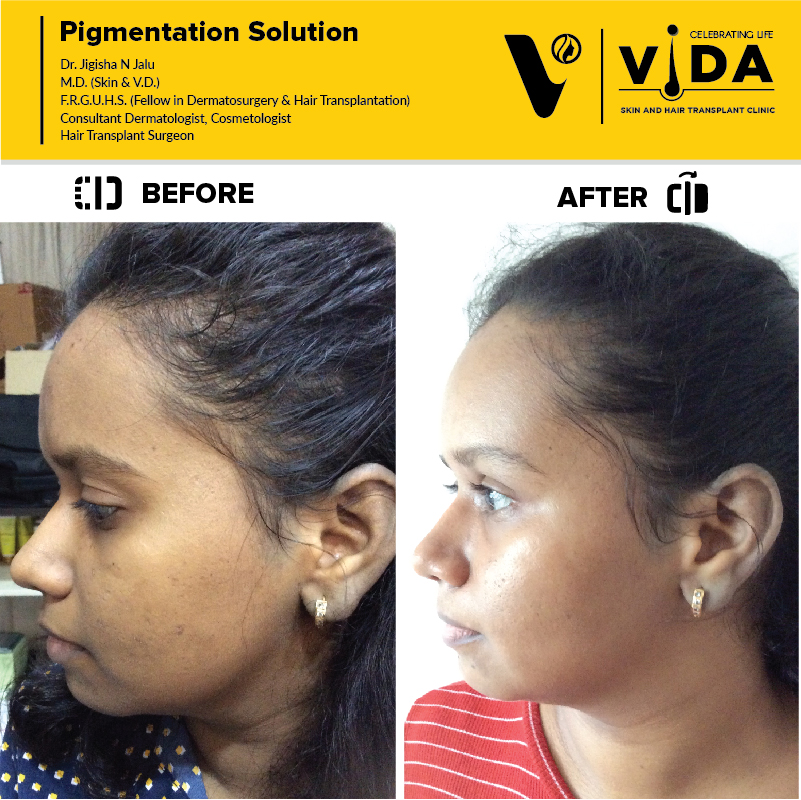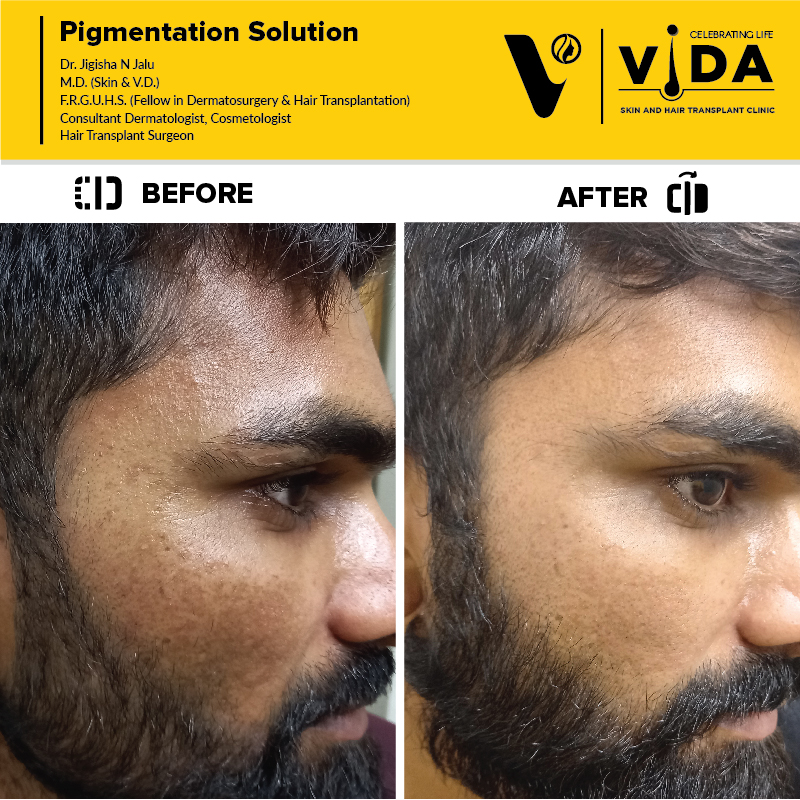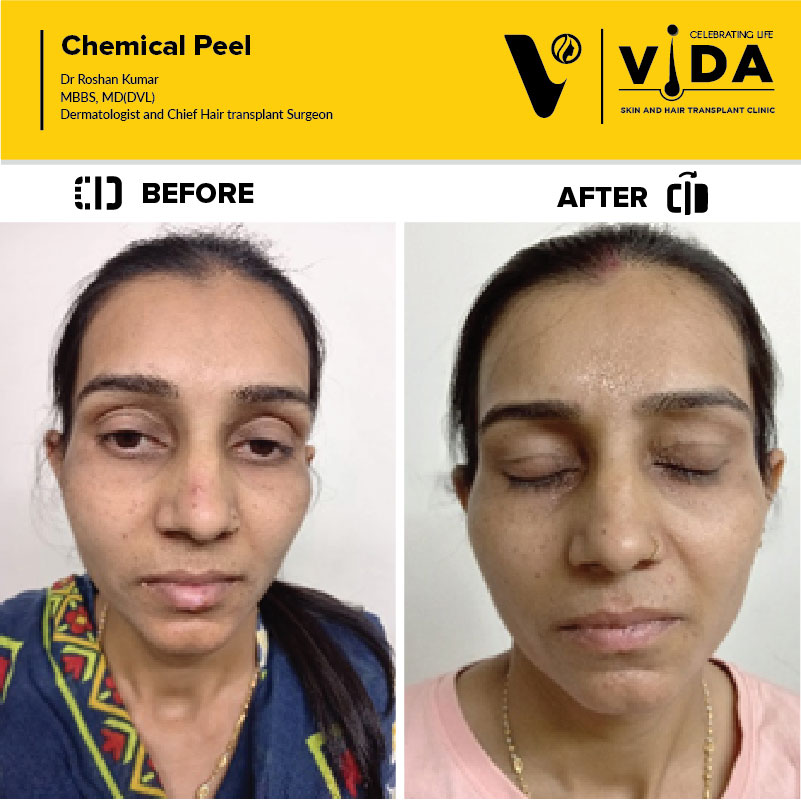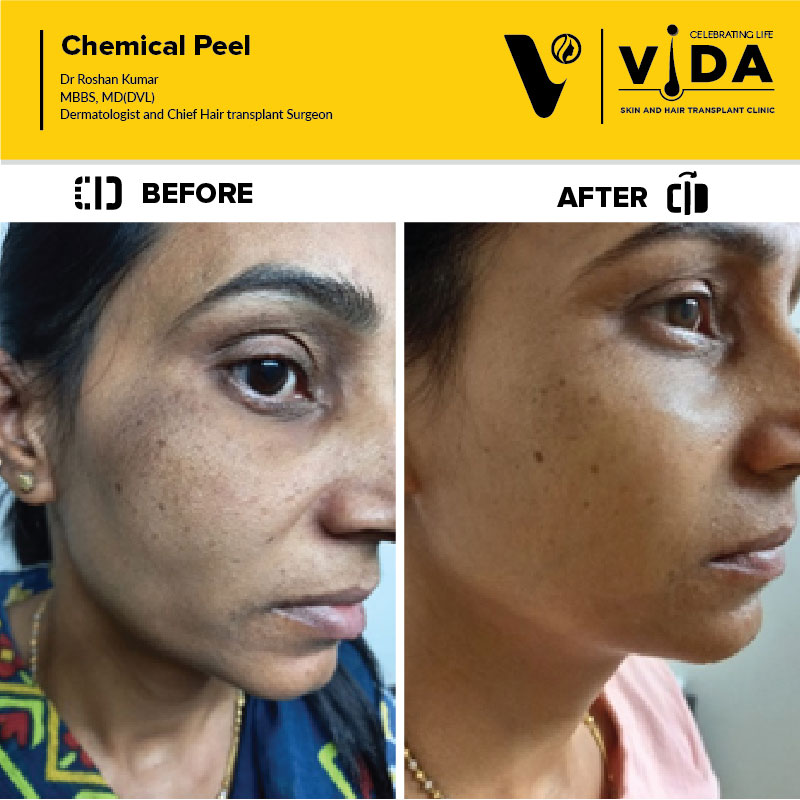Get personalized Consultation!
Pigmentation Solutions
Pigmentation issues can be a cause of concern for many individuals, affecting their overall self-confidence.
At Vida Skin and Hair Transplant Clinic, we understand the importance of addressing pigmentation for healthy and radiant skin.
Our clinic offers a range of innovative and effective pigmentation solutions that cater to various skin concerns and deliver remarkable results. In this article, we will explore the different types of pigmentation disorders, understand their causes, and delve into the various treatments available at Vida Skin and Hair Transplant Clinic.
Understanding Pigmentation
Pigmentation disorders occur when the skin produces either too much or too little melanin, the pigment responsible for the color of our skin, hair, and eyes. There are several types of pigmentation disorders, each with its unique characteristics and causes.
Explanation of pigmentation causes
The causes of pigmentation disorders can vary significantly. Some common factors include sun exposure, hormonal changes, genetics, and even certain medications. Understanding the underlying cause plays a crucial role in determining the most effective treatment approach.
Different types of pigmentation disorders
- Hyperpigmentation: This condition occurs when the skin produces excess melanin, resulting in darker patches or spots on the skin. Hyperpigmentation can be caused by sun damage, inflammation, acne, or hormonal changes.
- Hypopigmentation: Hypopigmentation, on the other hand, happens when the skin produces insufficient melanin, leading to lighter patches or areas devoid of color. Conditions like vitiligo and albinism are examples of hypopigmentation.
- Melasma: Melasma is a specific type of hyperpigmentation that primarily affects women. It involves the development of brown or grayish patches, typically on the face, due to hormonal fluctuations, pregnancy, or sun exposure.
Impact of pigmentation on skin health
Pigmentation issues not only affect the aesthetic appearance of the skin but can also impact its overall health. Conditions like melasma and hyperpigmentation can cause emotional distress, leading to low self-esteem and confidence. Addressing pigmentation is, therefore, crucial for maintaining both healthy skin and a positive self-image.


Chemical Peel: Peeling Away Imperfections
What is a chemical peel?
A chemical peel is a non-invasive procedure that involves applying a chemical solution to the skin to remove the damaged outer layers. The depth of the peel can vary depending on the specific skin concern being addressed.
How chemical peels work on pigmentation
Chemical peels work on pigmentation by exfoliating the skin, stimulating the production of collagen, and promoting the growth of new, healthy cells. The exfoliation process helps to reduce the appearance of pigmentation, revealing a brighter and more even-toned complexion.
Types of chemical peels
- Superficial peels: These peels are mild and target the outermost layer of the skin. They are effective in treating mild pigmentation issues and require minimal downtime.
- Medium peels: Medium peels penetrate deeper into the skin, reaching the middle layers. They can address moderate pigmentation concerns and require a longer recovery period.
- Deep peels: Deep peels provide the most dramatic results and are suitable for severe pigmentation issues. They target deeper layers of the skin and may require extensive downtime for proper healing.


Cosmelan Peel: Targeted Treatment for Stubborn Pigmentation
The cosmelan peel is a specialized treatment designed to specifically target stubborn pigmentation, including melasma. It is a multi-step process that involves the application of a mask and an at-home maintenance regimen.
Mechanism of action in treating pigmentation
The cosmelan peel works by inhibiting the production of melanin, effectively reducing the appearance of pigmentation. It also helps to regulate the transfer of melanin to the skin cells, ensuring a more even complexion.
Advantages and considerations
The cosmelan peel offers several advantages, including high efficacy and long-lasting results. It is suitable for all skin types and can be customized to address individual concerns. However, it may involve some initial discomfort and require adherence to a strict post-treatment care routine.
Comparisons with other peel treatments
Compared to other peel treatments, the cosmelan peel is specifically formulated to target stubborn pigmentation, making it highly effective in addressing melasma and other challenging pigmentation issues. Its unique multi-step approach and targeted action set it apart from traditional chemical peels.

Medi Facials: Nourishing Skin from Within
Definition and purpose of medi facials
Medi facials, also known as medical-grade facials, go beyond traditional facials to provide targeted treatments for various skin concerns, including pigmentation. They are administered by trained professionals and utilize medical-grade products to deliver optimal results.
Specific ingredients targeting pigmentation
Medi facials employ specific ingredients known for their ability to target pigmentation. Ingredients such as vitamin C, kojic acid, and alpha hydroxy acids (AHAs) work together to lighten dark spots, even out skin tone, and promote a brighter complexion.
Popular medi facial treatments
- Vitamin C infusion: Vitamin C is a powerful antioxidant that helps prevent further pigmentation and brightens the skin. An infusion of vitamin C during a medi facial can provide a significant boost in achieving a more even complexion.
- Micro-needling with PRP: Micro-needling combined with platelet-rich plasma (PRP) can stimulate collagen production and improve the appearance of pigmentation. This treatment promotes the growth of new, healthy skin cells, resulting in a more radiant complexion.
Expected results and maintenance
Depending on the specific medi facial treatment, results can vary. However, most patients can expect noticeable improvements in their pigmentation concerns after a series of treatments. Regular maintenance and a proper skincare routine can help prolong the results.
Mesotherapy: Precision Treatment for Pigmentation Woes
Overview of mesotherapy
Mesotherapy is a minimally invasive treatment that involves injecting a customized cocktail of vitamins, minerals, and enzymes directly into the mesodermal layer of the skin. It can be an effective solution for various skin concerns, including pigmentation.
How mesotherapy addresses pigmentation
Mesotherapy targets pigmentation by delivering a potent blend of ingredients directly to the affected areas of the skin. This helps to break up pigmented cells, promotes collagen production, and stimulates the skin’s natural healing process for a more even complexion.
Suitable candidates and expected outcomes
Suitable candidates for mesotherapy are individuals with pigmentation concerns that haven’t responded well to other treatments. Mesotherapy can provide significant improvements in pigmentation, resulting in a smoother and more youthful-looking complexion.
Risks and considerations
While mesotherapy is generally considered safe, some potential risks include bruising, swelling, or infection at the injection sites. It is important to consult with a qualified professional to ensure the treatment is appropriate for individual circumstances.
Hydra Facial: Hydration and Pigmentation Solutions Combined
Understanding hydra facials
Hydra facial is a cutting-edge facial treatment that combines gentle exfoliation, deep cleansing, and intense hydration to promote healthier, more radiant skin. It is a versatile treatment that can also help address pigmentation concerns.
Role of hydration in combating pigmentation
Proper hydration is crucial for maintaining healthy skin and combating pigmentation issues. Hydra facials infuse the skin with a hydrating serum, boosting moisture levels and promoting a plump, glowing complexion, which in turn helps to reduce the visibility of pigmentation.
Procedure details and variations
The hydra facial treatment involves a series of steps, including cleansing, exfoliation, extraction, hydration, and protection. Each step is customized based on individual skin concerns, allowing for targeted treatment of pigmentation. Variations in the treatment can include specific serums or boosters to further address pigmentation issues.
Post-treatment care and results
Following a hydra facial, it is important to maintain a good skincare routine and protect the skin from sun exposure. Results from a hydra facial can be seen immediately, with the skin appearing brighter, more even toned, and rejuvenated. Regular treatments can help maintain these results over time.
Microdermabrasion: Exfoliating for a Brighter Tomorrow
What is microdermabrasion?
Microdermabrasion is a non-invasive exfoliation treatment that removes the outermost layer of dead skin cells, revealing a smoother and brighter complexion. It can be an effective treatment for mild to moderate pigmentation concerns.
How microdermabrasion helps with pigmentation
Microdermabrasion exfoliates the skin, effectively removing the damaged and pigmented cells on the surface. By stimulating cell turnover, microdermabrasion promotes the growth of new, healthy cells, resulting in a reduction in pigmentation and a more even skin tone.
Different types of microdermabrasion
There are two main types of microdermabrasion: crystal and diamond. Crystal microdermabrasion involves the use of fine crystals to exfoliate the skin, while diamond microdermabrasion utilizes a diamond-tipped wand for gentle and precise exfoliation.
Safety measures and expected downtime.
Microdermabrasion is generally safe when performed by a trained professional. Some individuals may experience mild redness or sensitivity following the treatment, but these effects typically subside within a few hours. It is important to follow post-treatment instructions and protect the skin from sun exposure.
Semi-Permanent Makeup: Enhancing Beauty, Concealing Pigmentation
Introduction to semi-permanent makeup
Semi-permanent makeup, also known as micropigmentation or cosmetic tattooing, is a procedure that involves depositing colored pigments into the skin to enhance features and conceal imperfections, including pigmentation issues.
How it conceals pigmentation issues
Semi-permanent makeup can help conceal pigmentation issues by providing a long-lasting color that matches the natural skin tone. Procedures such as microblading for the eyebrows and lip blushing for the lips can create a more symmetrical and even appearance, reducing the visibility of pigmentation concerns.
Popular semi-permanent makeup procedures
- Microblading: Microblading is a technique that creates natural-looking eyebrows by manually implanting hair-like strokes with a specialized tool. It can help fill in sparse areas and create a more defined brow shape, camouflaging pigmentation issues.
- Lip blushing: Lip blushing involves depositing a tinted pigment into the lips to enhance their color and shape. This procedure can create the illusion of fuller, more even-toned lips, minimizing the appearance of pigmentation concerns.
Considerations and aftercare
Before opting for semi-permanent makeup, it is essential to consult with a skilled professional to discuss desired outcomes and potential risks. Aftercare instructions should be followed carefully to ensure proper healing and long-lasting results.
Choosing the Right Pigmentation Solution
Factors to consider before selecting a treatment
Before choosing a pigmentation solution, it is important to consider factors such as the severity of the pigmentation, individual skin type and sensitivity, desired results, and personal preferences. Consulting with a dermatologist or skincare professional can help determine the most suitable treatment option.
Consultation with dermatologists and skincare professionals
A consultation with a dermatologist or skincare professional is crucial in identifying the underlying causes of pigmentation and determining the most effective treatment approach. These experts can assess the skin condition, recommend suitable treatments, and create personalized skincare plans.
Personalized skincare plans for pigmentation concerns
At Vida Skin and Hair Transplant Clinic, we believe in tailoring treatment plans to meet the unique needs of our clients. Our skincare professionals will create a personalized plan that combines various treatments and products to address pigmentation concerns effectively. Regular follow-ups and adjustments ensure optimal results and long-term skin health.
Taking the first step towards addressing pigmentation concerns is essential for healthy and radiant skin. Vida Skin and Hair Transplant Clinic offers a comprehensive range of pigmentation solutions, including chemical peels, the cosmelan peel, medi facials, mesotherapy, hydra facials, microdermabrasion, and semi-permanent makeup. With the guidance of our experienced professionals, you can achieve the flawless complexion you desire. Contact Vida Skin and Hair Transplant Clinic today to embark on your journey towards pigmentation-free skin.
Preparing for Pigmentation Treatments
Before embarking on any pigmentation treatment at Vida Skin and Hair Transplant Clinic, it is essential to prepare your skin and mind for the journey ahead. The following steps will help ensure optimal results and a smooth treatment process.
Pre-treatment skincare routine
To maximize the effectiveness of pigmentation treatments, it is crucial to establish a consistent pre-treatment skincare routine. This routine should focus on nourishing and protecting your skin, creating a solid foundation for the upcoming treatments.
Start by cleansing your face twice daily with a gentle cleanser suitable for your skin type. This will remove impurities and prepare your skin for the pigmentation solutions. Follow up with a hydrating toner to restore the skin’s pH balance and improve absorption of subsequent products.
Next, incorporate a high-quality sunscreen into your daily routine. The sun’s damaging UV rays can exacerbate pigmentation issues, so protecting your skin is vital. Look for a broad-spectrum sunscreen with at least SPF 30, and remember to reapply throughout the day, especially if you spend extended periods outdoors.
In addition to the basics, consider using serums and moisturizers that target pigmentation concerns. Look for ingredients like vitamin C, niacinamide, or kojic acid, known for their brightening properties. These products can help fade existing pigmentation and prevent further discoloration.
Avoiding certain activities before treatment
Before your pigmentation treatment at Vida Skin and Hair Transplant Clinic, it’s important to make a few lifestyle adjustments to ensure optimal results. Avoid excessive sun exposure, as this can cause the pigmentation to worsen and interfere with the treatment process.
Furthermore, if you’re using any products or undergoing treatments that could potentially irritate your skin, such as chemical peels or laser treatments, it is advisable to pause these treatments a few weeks before your pigmentation solution. This will allow your skin to heal and reduce the risk of adverse reactions.
Lastly, it’s recommended to avoid waxing or other hair removal methods in the treatment area for a week or two before your session. These treatments can irritate the skin and make it more susceptible to potential side effects.
Mental preparation and expectations
While pigmentation solutions at Vida Skin and Hair Transplant Clinic are highly effective, it’s essential to approach the treatment process with realistic expectations and a positive mindset.
Understand that pigmentation issues can take time to resolve completely, and multiple sessions may be required. Remember that everyone’s skin is unique, and results may vary. Trust in the expertise of the skilled professionals at Vida Skin and Hair Transplant Clinic, who will guide you through the journey to radiant and healthy skin.
The Treatment Process
Now that you’re well-prepared, let’s delve into the treatment process for pigmentation solutions at Vida Skin and Hair Transplant Clinic. Each method follows a step-by-step guide, ensuring a comprehensive and personalized approach to your unique skin concerns.
Step-by-step guide for each pigmentation solution
- Chemical Peels: This treatment involves the application of a solution containing various acids, which exfoliates the top layer of the skin and encourages new skin cell growth. The process typically consists of cleansing the skin, applying the chemical peel solution, and then neutralizing and removing it after a specific time interval.
- Laser Therapy: Laser treatments utilize focused beams of light to target and break down pigmented areas of the skin. The procedure starts with cleansing the skin and applying a cooling gel or numbing cream if necessary. The laser is then used to precisely target the pigmented areas, stimulating collagen production and promoting skin rejuvenation.
- Microdermabrasion: This non-invasive treatment involves the gentle exfoliation of the skin using a handheld device equipped with fine crystals or a diamond-tipped wand. It effectively removes dead skin cells and irregularities, revealing fresher, more even-toned skin. The process typically begins with cleansing the skin, followed by the controlled exfoliation process using the microdermabrasion device.
Duration of treatments and expected sensations
The duration of pigmentation treatments at Vida Skin and Hair Transplant Clinic varies depending on the chosen solution and the severity of the pigmentation concern. Generally, each session lasts between 30 minutes to an hour.
During the treatments, you may experience mild sensations such as tingling, warmth, or a slight stinging sensation, depending on the chosen method. However, discomfort is usually minimal and well-tolerated by most individuals.
What to expect during and after treatment sessions
Throughout the treatment sessions, the experienced professionals at Vida Skin and Hair Transplant Clinic will ensure your comfort and safety. They will provide protective eyewear and take all necessary precautions to minimize any potential risks.
After each session, you may experience temporary redness, mild swelling, or slight dryness in the treated area. These effects are normal and typically subside within a few hours to a few days, depending on the intensity of the treatment. Applying the recommended post-treatment products and following the provided care instructions will help alleviate any discomfort and promote optimal healing.
Post-Treatment Care and Maintenance
Post-treatment care and maintenance play a crucial role in achieving long-lasting results and maintaining the improvements achieved through pigmentation solutions. Implementing the following measures will optimize the outcome of your treatment at Vida Skin and Hair Transplant Clinic.
Importance of post-treatment care
Proper post-treatment care is essential to ensure the best possible results and minimize the risk of complications. Following the instructions provided by the medical professionals at Vida Skin and Hair Transplant Clinic will help you navigate the healing process smoothly.
Skincare routine adjustments
Adjusting your skincare routine post-treatment is important to support the skin’s healing process and maximize the benefits of the pigmentation solutions. Avoid using harsh or abrasive products in the treated area and opt for gentle cleansers and moisturizers.
Additionally, incorporating hydrating serums and broad-spectrum sunscreens into your daily skincare routine will help maintain the improvements achieved during the pigmentation treatments. Regularly moisturizing the skin will also prevent dryness and promote a healthy skin barrier.
Follow-up appointments and touch-up considerations
Following your initial pigmentation treatment at Vida Skin and Hair Transplant Clinic, it is crucial to attend any scheduled follow-up appointments. These appointments allow the medical professionals to assess your progress, make any necessary adjustments, and provide additional recommendations for ongoing maintenance.
Depending on the severity of your pigmentation concerns, you may also require touch-up sessions to achieve the desired final outcome. The number of touch-ups needed will be determined by the medical professionals based on the individual response to the initial treatments.
Risks and Side Effects
As with any medical procedure, there are potential risks and side effects associated with pigmentation solutions. However, with proper care and expertise provided at Vida Skin and Hair Transplant Clinic, these risks can be minimized. It is crucial to be informed and educated about the potential risks before undergoing any treatment.
A. Potential risks associated with pigmentation solutions
Some potential risks include temporary hyperpigmentation or hypopigmentation, skin irritation, redness, swelling, or mild scarring. However, it’s important to note that these risks are relatively rare and can be minimized when performed by experienced professionals at Vida Skin and Hair Transplant Clinic.
B. Strategies for minimizing risks
Vida Skin and Hair Transplant Clinic prioritizes patient safety and follows strict protocols to minimize risks associated with pigmentation solutions. By ensuring a thorough consultation, comprehensive health assessment, and meticulous treatment execution, the medical professionals aim to provide the best possible outcomes while minimizing any potential complications.
C. Importance of informed consent and thorough consultation
Before undergoing any pigmentation treatments, it is crucial to have a thorough consultation with the medical professionals at Vida Skin and Hair Transplant Clinic. They will assess your individual needs, explain the potential risks and benefits, and make recommendations based on your specific situation. Informed consent ensures that you are fully aware of the treatment process and can make an informed decision.
Conclusion
In conclusion, Vida Skin and Hair Transplant Clinic offers effective and personalized pigmentation solutions to help you achieve radiant and healthy skin. By following the pre-treatment skincare routine, adequately preparing for the treatment process, and implementing proper post-treatment care, you can maximize the outcomes and maintain the improvements achieved.
Remember that pigmentation treatments require time and multiple sessions, and results may vary. Trusting the expertise of the professionals at Vida Skin and Hair Transplant Clinic will guide you on your journey to achieving the skin you desire. Don’t hesitate to seek professional advice and embark on the path to radiant and healthy skin.
Frequently Asked Questions!
Pigmentation issues can be caused by various factors, including sun exposure, hormonal changes, genetics, and skin inflammation. These factors can lead to an overproduction or uneven distribution of melanin, resulting in dark spots or discoloration.
If you notice dark spots, uneven skin tone, or other pigmentation concerns, you may benefit from pigmentation solutions. Consulting with a dermatologist or skincare professional can help determine the most suitable treatment based on your specific skin needs.
Common pigmentation solutions include chemical peels, laser treatments, topical lightening agents, microdermabrasion, and skincare products containing ingredients like vitamin C and retinoids. The choice of solution depends on the type and severity of pigmentation.
Many pigmentation solutions are suitable for various skin types, but the effectiveness can vary. It’s essential to choose treatments that are appropriate for your skin type and tone and to consult with a skincare professional for personalized advice.
When performed by qualified professionals, pigmentation solutions are generally safe. However, there may be mild side effects such as redness or temporary irritation. It’s crucial to follow post-treatment care instructions and inform your provider of any allergies or sensitivities.
The timeline for seeing results depends on the type of treatment. Some solutions, like topical products, may show gradual improvement over weeks, while procedures such as laser treatments may provide more immediate results.
In some cases, pigmentation may return, especially if the underlying causes are not addressed. Maintaining a consistent skincare routine, using sun protection, and addressing contributing factors can help prolong the results of pigmentation treatments.
Certain treatments may not be recommended during pregnancy due to potential risks. It’s crucial to inform your healthcare provider if you are pregnant or planning to become pregnant before considering pigmentation solutions.
Preventing pigmentation issues involves consistent sun protection, avoiding excessive sun exposure, and using skincare products with antioxidants and ingredients that promote even skin tone. A healthy lifestyle and managing stress can also contribute to skin health.
While natural remedies like aloe vera, licorice extract, and certain oils may have mild lightening effects, they may not provide significant results for all types of pigmentation. Professional treatments and medical-grade skincare products are often more effective for addressing stubborn pigmentation concerns.